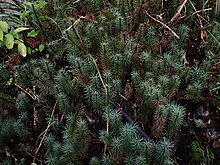| Dawsonia superba | |
|---|---|

| |
| In Coromandel Forest Park | |
| Scientific classification | |
| Kingdom: | Plantae |
| Division: | Bryophyta |
| Class: | Polytrichopsida |
| Order: | Polytrichales |
| Family: | Polytrichaceae |
| Genus: | Dawsonia |
| Species: | D. superba
|
| Binomial name | |
| Dawsonia superba Grev., 1847
| |
| Synonyms[1] | |
| |
Dawsonia superba is a moss in the family Polytrichaceae that is found in Australia, New Guinea, Malaysia,[2] and New Zealand.[3] D. superba is the tallest self-supporting moss in the world, reaching heights of 60 cm (24 in).[4] It has analogous structures to those in vascular plants that support large size, including hydroid and leptoid cells to conduct water and photosynthate,[4] and lamellae that provide gas chambers for more efficient photosynthesis.[5] D. superba is a member of the class Polytrichopsida, although it has a sporophyte that is unique from other hair-cap mosses.[5]
There is some confusion surrounding if Dawsonia superba and Dawsonia longifolia are distinct species or refer to the same moss. According to some sources, Dawsonia longifolia and Dawsonia superba have been merged.[4] For a long time, both D. longifolia and D. superba were used to refer to the same species, with some regional variation in its use.[6] Both terms are still used.
- ^ Cite error: The named reference
WFOwas invoked but never defined (see the help page). - ^ Cite error: The named reference
Eakin 1998was invoked but never defined (see the help page). - ^ Cite error: The named reference
nzplantswas invoked but never defined (see the help page). - ^ a b c Cite error: The named reference
Glime 2011was invoked but never defined (see the help page). - ^ a b Cite error: The named reference
Bell et al. 2021was invoked but never defined (see the help page). - ^ Cite error: The named reference
van Zanten 1997was invoked but never defined (see the help page).